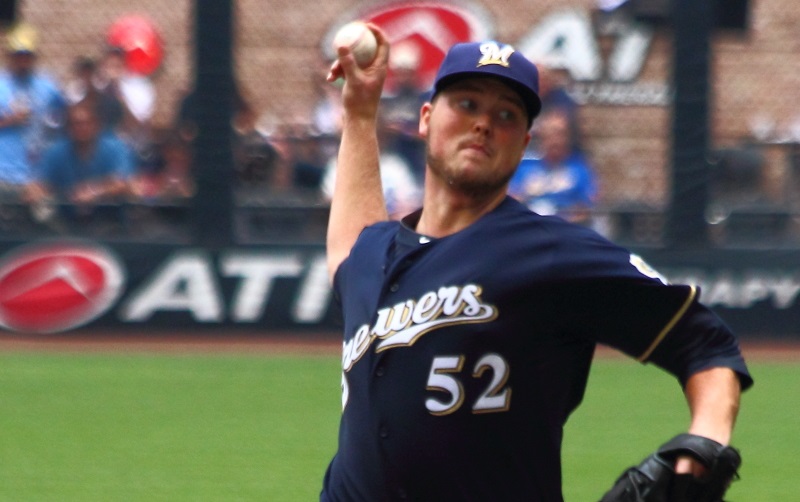The Dodgers haven’t addressed their starting rotation yet this winter. They whiffed on Gerrit Cole, didn’t have much of a chance at Stephen Strasburg and weren’t going to meet the asking price for Zack Wheeler. They also lost Hyun-Jin Ryu to the Blue Jays and Rich Hill‘s status (despite bieng a free agent) is still to be determined.
I wrote a little about their starting rotation on Sunday. As it stands right now, it’s a perfectly fine (potentially) seven-man rotation, but there’s a lot more volatility than there has been at any time over the last seven years. If the Dodgers don’t add anyone, they’ll be leaning heavily on rookies Tony Gonsolin and Dustin May, as well as Julio Urias (limited to 184 innings in his four MLB seasons) and Ross Stripling, who pitched well enough in the starting rotation in 2018 to make the All-Star team but whose ceiling is also relatively limited. They’re definitely interested in Mike Clevinger, but his acquisition cost will be astronomical. They might be looking at David Price (who would likely come with Mookie Betts), but the 34-year-old is not the same pitcher he was even three years ago.
If they’re going to go the high-upside route and don’t want to pay for it — prospect or money-wise — then Jimmy Nelson might be the guy the Dodgers seek. Nelson, 30, is coming off an abbreviated 2019 season as he recovered from a shoulder injury that cost him the entire 2018 season and an elbow injury that kept out from June 26 until Sept. 5 (after not making his 2019 debut in the minors until May 3).
In 2017, Nelson was putting together a fantastic campaign as he pitched to a 3.49 ERA, 3.05 FIP, a 20.8 K-BB% and a 4.8 WAR. After a 5-inning scoreless outing against the Cubs on Sept. 8, Nelson had surgery just two weeks later to repair a partially torn labrum, strained rotator cuff and an issue with the joint. It was a serious operation and it has taken quite some time for him to get back to the majors.
He made four starts and one relief appearance in June before going on the injured list with elbow effusion (liquid in the joint). Here’s his velocity breakdown in 2019.
| Month | 4FB velo | SNK velo | SLD velo |
| June | 92.14 | 92.98 | 85.52 |
| September | 93.86 | 93.77 | 86.30 |
He saw a slight uptick in velocity across the board, but that could be at least partially attributed to pitching exclusively in relief in September. But even before the elbow flare up (that had bothered him since Spring Training), he wasn’t too far from league-average velocity (for starting pitchers) on his 4-seam fastball (93.0 MPH) and bested it on his sinker (91.7).
Nelson has a legitimate 4-pitch mix that features a fastball, sinker, curveball and slider. He also has a seldom used changeup. Here are his whiff rates on each pitch in 2016, ’17 and ’19.
| Year | 4FB | SNK | SLD | CB |
| 2016 | 9.79 | 4.94 | 16.15 | 9.26 |
| 2017 | 13.77 | 7.05 | 18.12 | 15.19 |
| 2019 | 10.00 | 4.50 | 19.27 | 7.32 |
Despite the ailments, Nelson actually improved his whiff rate on his slider in an admittedly small sample size. The more concerning part is the lack of whiffs on his curveball, especially since he threw it 20.25 percent of the time last season. The explanation: the lack of vertical movement, which went the wrong direction in 2019. Instead of having a hard, more biting curveball, it got a bit loopier and thus, hitters were able to time it, hit it well (.313 batting average against) and didn’t miss it very often. He compensated by using his slider as his primary out pitch.
Nelson showed flashes of brilliance in 2017. He was on his way to being the unquestioned ace of the Brewers’ staff. The talent is there and there is enough evidence to suggest that he could get somewhere near that level again, as long as he’s healthy. The Dodgers have had great success with pitchers coming back from major shoulder injuries (Ryu and Urias), as well as pitchers with elbow issues (Walker Buehler). And the way they use their starters, the Dodgers and Nelson might be a perfect fit.
However, there’s a reason no one has signed him yet. The Brewers — starved for pitching in their own right — non-tendered Nelson on Dec. 2 and didn’t want to pay him a paltry $3.7 million he was projected to make in his final season of arbitration. Every team out there knows Nelson has a high ceiling, but there must be serious questions about whether he can not only stay healthy but stay healthy for long enough to make a difference in a rotation.
With the Dodgers ability to limit pitchers’ workloads, Nelson could be a guy they deploy as a starter, a reliever or a multi-inning guy. In fact, if the signed Nelson and brought Hill back, that’d be a pretty interesting tandem, with each guy going 3-4 innings every 4-5 days or so. But the ultimate intention should be to see if he can get back to being an every-fifth-day guy.
Nelson has No. 2-type stuff and has the requisite spin rates on his fastball and curveball the Dodgers like. He’s going to be cheap and could help alleviate some of the concerns in the rotation. Of course, trading for a guy like Clevinger would really alleviate those concerns, but if history is any indicator, Andrew Friedman will likely go the reclamation route rather than give up the necessary players or spend bigger money to acquire more of a sure thing.
 Dodgers Digest Los Angeles Dodgers Baseball Blog
Dodgers Digest Los Angeles Dodgers Baseball Blog
